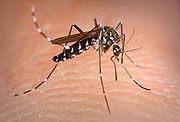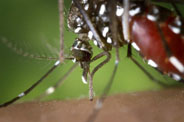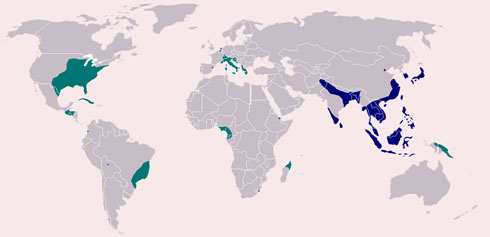The Asian tiger mosquito or forest day mosquito Aedes albopictus is characterized by its black and white striped legs and small black and white body (see Figure 1). It is native to the tropical and subtropical areas of Southeast Asia; however, in the past couple of decades, this species has invaded many countries worldwide through transporting goods and increasing international travel. This mosquito has become a significant pest in many communities because it is closely associated with humans (rather than living in wetlands) and typically flies and feeds in the daytime, dusk, and dawn.


Figure 1: Asian tiger mosquito or Aedes albopictus. Note its black and white striped legs and small black and white body.
The Asian tiger mosquito is about 2 to 10 mm in length and has a striking white and black pattern. The variation of the body size in adult mosquitoes depends on the density of the larval population and the food supply within the breeding water. Since these circumstances are seldom optimal, the average body size of adult mosquitoes is considerably smaller than 10 mm.
The males are roughly 20% smaller than the females but are morphologically very similar. However, as in all mosquito species, the antennae of the males, in comparison to the females, are noticeably bushier and contain auditory receptors to detect the characteristic whine of the female. The maxillary palps of the males are also longer than their probosci,ses whereas the females’ maxillary palps are much shorter. In addition, the tarsus of the hind legs of the males is more silvery. Tarsomere IV is roughly three-quarters silver in the males, whereas females are only about 60% silver. The other characteristics do not differentiate between sexes. A single silvery-white line of tight scales begins between the eyes and continues down the dorsal side of the thorax. This characteristic marking is the easiest and surest way to identify the Asian tiger mosquito.
The proboscis is dark colored, the upper surface of the end segment of the palps is covered in silvery scales, and the labium does not feature a light line on its underside. The compound eyes are distinctly separated from one another. The scutum, the dorsal portion of an insect’s thoracic segment, is black alongside the characteristic white midline. On the side of the thorax, the scutellum, and the abdomen, numerous spots are covered in white-silvery scales.
Such white-silvery scales can also be found on the tarsus, particularly on the hind legs that are commonly suspended in the air. The base of tarsomere I through IV has a ring of white scales, creating the appearance of white and black ringOnlynly the first three tarsomeres have a ring of white sca on the forelegs and mmid middleelegs, ,reasarsomere V on the hind legs is completely white. The femur of each leg is also black with white scales on the end of the “kn.”. The femurs of the middle legs do not feature a silver line on the base of the upper side, whereas the femurs on the hind legs have short white lines on the base of the upper side. The tibias are black on the base and have no white scales. The terga on segments II through VI of the abdomen are dark and have an almost triangular silvery-white marking on the base that is not aligned with the silvery bands of scales on the ventral side of the abdomen. The triangular marking and the silvery band are only aligned on abdominal segment VII. The transparent wings have white spots on the base of the Costas. The scales could be partially worn off with older mosquito specimens, making the previously mentioned characteristics less noticeable.
The Aedes albopictus mosquito has a rapid bite that allows it to escape most attempts by people to swat it. By contrast, the male member of the species primarily feeds on nectar. The female mosquito also bites other mammals and birds besides humans. They are always searching for a host and are persistent and cautious regarding their blood meal and host location. Their blood meal is often broken off short without enough blood ingested to develop their eggs. This is why Asian tiger mosquitoes bite multiple hosts during the development cycle of the egg, making them particularly efficient at transmitting diseases. The mannerism of biting diverse host species enables the Asian tiger mosquito to be a potential bridge vector for certain pathogens, such as the West Nile Virus and Dengue Virus. The female lays eggs near water, not directly into it as other mosquitoes do, but typically near a stagnant pool. However, any open container containing water will suffice for larvae development, even with less than an ounce of water. It can also breed in running water, so stagnant pools of water are not its only breeding sites. It has a short flight range (less than 200 m), so breeding sites are likely to be close to where this mosquito is found.

Distribution
Although Aedes albopictus is native to tropical and subtropical regions, they successfully adapt to cooler areas. In the warm and humid tropical areas, they are active the entire year long, however, in the temperate regions they hibernate over winter. Eggs from strains in the temperate zones are more tolerant to the cold than ones from warmer regions. They can even tolerate snow and temperatures under freezing. In addition, adult tiger mosquitoes can survive throughout winter in suitable microhabitats. Originally, the Asian tiger mosquito came from Southeast Asia. In 1967, parts of Asia, the island worlds of India, and the Pacific Ocean were denoted as the areas of circulation for the Asian tiger mosquito. Since then, it has spread to Europe, the Americas, the Caribbean, Africa, and the Middle East (see Figure 2).
In Asia, the Asian tiger mosquito can be mistaken for other members of the subgenus Stegomyi because they frequently display a similar black-and-white pattern, particularly the most prevalent species in the tropics and subtropics, the yellow fever mosquito,o, Aedes aegypti. It can be hard to distinguish Aedes albopictus from the closely related Aedes scutellaris (India, Indonesia, Papua New Guinea, and the Philippines), Aedes pseudoalbopictus (India, Indonesia, Malaysia, Myanmar, Nepal, Taiwan, Thailand, and Vietnam) and Aedes season (Thailand).